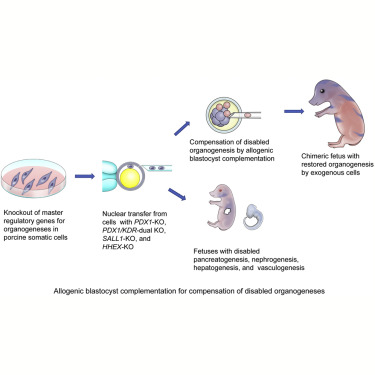Stem Cell Reports ( IF 5.9 ) Pub Date : 2019-12-26 , DOI: 10.1016/j.stemcr.2019.11.008 Hitomi Matsunari 1 , Masahito Watanabe 1 , Koki Hasegawa 2 , Ayuko Uchikura 2 , Kazuaki Nakano 2 , Kazuhiro Umeyama 1 , Hideki Masaki 3 , Sanae Hamanaka 3 , Tomoyuki Yamaguchi 3 , Masaki Nagaya 1 , Ryuichi Nishinakamura 4 , Hiromitsu Nakauchi 5 , Hiroshi Nagashima 6

|
We have previously established a concept of developing exogenic pancreas in a genetically modified pig fetus with an apancreatic trait, thereby proposing the possibility of in vivo generation of functional human organs in xenogenic large animals. In this study, we aimed to demonstrate a further proof-of-concept of the compensation for disabled organogeneses in pig, including pancreatogenesis, nephrogenesis, hepatogenesis, and vasculogenesis. These dysorganogenetic phenotypes could be efficiently induced via genome editing of the cloned pigs. Induced dysorganogenetic traits could also be compensated by allogenic blastocyst complementation, thereby proving the extended concept of organ regeneration from exogenous pluripotent cells in empty niches during various organogeneses. These results suggest that the feasibility of blastocyst complementation using genome-edited cloned embryos permits experimentation toward the in vivo organ generation in pigs from xenogenic pluripotent cells.
中文翻译:

通过囊胚互补补偿转基因猪胎儿中残疾的器官发生。
我们之前已经建立了在具有胰脏特征的转基因猪胎儿中发育外源胰腺的概念,从而提出了在异种大型动物体内产生功能性人体器官的可能性。在这项研究中,我们的目的是进一步验证猪器官发生障碍的补偿,包括胰腺发生、肾发生、肝发生和血管发生。这些器官发育不良表型可以通过克隆猪的基因组编辑有效诱导。诱导的器官发育不良性状也可以通过同种异体囊胚互补来补偿,从而证明了在各种器官发生期间从空位中的外源多能细胞进行器官再生的扩展概念。这些结果表明,使用基因组编辑的克隆胚胎进行囊胚互补的可行性允许在猪体内利用异种多能细胞进行器官生成实验。


















































 京公网安备 11010802027423号
京公网安备 11010802027423号